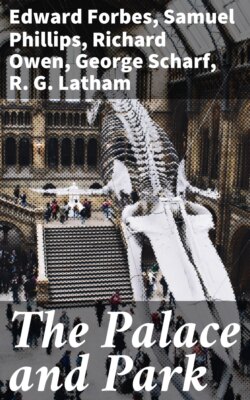Читать книгу The Palace and Park - Edward Winslow Forbes - Страница 20
На сайте Литреса книга снята с продажи.
THE STATIONERY COURT.[20]
ОглавлениеIn the formation of this and of the other Industrial Courts, the several architects have been solicitous to express, both in the construction and the decoration, as far as possible, the specific destination; with the view of maintaining some harmony between the objects exhibited and the building in which they are contained. The Stationery Court was designed and erected by Mr. J. G. Crace. The style of this Court is composite, and may be regarded as the application of cinque-cento ornamental decoration to a wooden structure. Externally the aim has been to furnish certain coloured surfaces, which shall harmonise with the plants around and with the general aspect of the Palace. In the interior of the Court, the colour on the lower level will be seen to serve as an admirable background to the objects exhibited; whilst the panels covered with cinque-cento decoration, combined with the elegant imitation of marquetrie work, produce an effect which deserves the highest praise. Over the opening through which we enter this Court, and between the stained glass windows let into the wall, have been introduced allegorical figures of the arts and sciences applied in the manufacture of the articles exhibited in the Court, and over the opening at the back the artist has depicted the Genii of Manufacture, Commerce, &c. In the centre of the panels throughout the Court representations are painted of the processes which the objects exhibited undergo during their manufacture.
[20] See “Exhibitors’ Descriptive Catalogue,” Part IV. of this book.
As the visitor passes round this Court, let him step out at one of the entrances on the north side, close to which he will find erected “The Crystal Palace Medal Press.” This machine, which is official, and worked on behalf of the Company by Messrs. T. R. Pinches & Co., is employed from time to time in striking commemorative medals, designed by Mr. Pinches or other artists connected with the Palace. The machine is worked by four men, one of whom adjusts the metal to be stamped between the sunk dies: as soon as the metal is fixed, the other workmen swing the lever rapidly round, and the great pressure produces impressions of the dies on the metal, which is turned out sharp and distinct, and then put into a lathe and completed. In the glass cases placed near, the visitor will have an opportunity of inspecting numerous specimens of the medals produced by the machine, amongst which those in frosted silver deserve especial notice for the beauty of their appearance.
The visitor, proceeding round the Stationery Court, from right to left, will find amongst the works of industry exhibited, specimens of Bank-note Engraving and Medallion Line-engraving, book-binding, and printing, including the new art of Nature-printing, paper manufacture, and Artists’ colours, also stereoscopic views and other articles of the kind. Outside this Court, between it and the Birmingham Court, are some beautiful and interesting specimens of artistic printing in colours. At the back of this and of the Birmingham Court, or towards the west front of the building, is situated “The Hardware Court,” in which are placed household utensils, iron and zinc bronzes, gas-fittings, refrigerators, and numerous articles in metals.
Immediately behind the Hardware and Stationery Courts, is a Court dedicated to New Inventions. This very interesting department is filled with ingenious contrivances of all kinds, and is well worthy of a visit.
Beyond this Court again, and flanking the Hardware Court, is a large space extending in a southerly direction to the Pompeian Court (at which the visitor will presently arrive), divided into several large chambers which are devoted to the exhibition of furniture. Here will be found not only useful articles of household furniture, but specimens of tapestry work, wood carving, picture frames, and other ornamental articles which give grace to our rooms, and which, by means of our great mechanical excellence, are daily becoming more and more within the reach of the great body of the people. The visitor will do well, in examining these Courts, to view them in sections, so as not to miss those Industrial Courts which face the Nave.
Next in order of the Industrial establishments, comes
